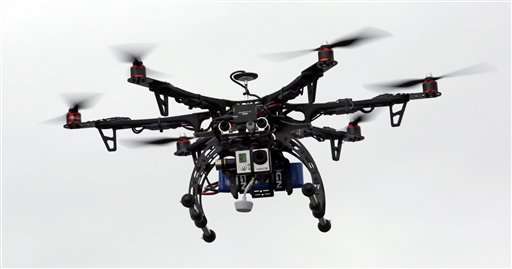In this Feb. 13, 2014 file photo, a drone is demonstrated in Brigham City, Utah. Researchers say there have been at least 241 reports of close encounters between drones and manned aircraft that meet the government's definition of a near midair collision, including 28 in which pilots maneuvered to get out of the way. A report released Friday by Bard College's Center for the Study of the Drone in New York says 90 of the close encounters involved drones and commercial jets, the majority of which had the capacity to carry 50 people or more. (AP Photo/Rick Bowmer, File)
There has yet to be a confirmed U.S. collision between a drone and a manned aircraft, but there's a growing number of close calls as drones fly where they least belong—near airports.
A report released Friday counted at least 241 reports of close encounters between drones and manned aircraft that meet the Federal Aviation Administration's definition of a near-collision, including 28 incidents in which pilots had to veer out of the way.
The analysis by Bard College's Center for the Study of the Drone found that 90 of the close drone encounters involved commercial jets.
The FAA defines a near-collision as two aircraft flying within 500 feet of each other. In 51 of the incidents studied, the drone-to-aircraft clearance was 50 feet (15 meters) or less, the report said.
Most of the sightings occurred within 5 miles (8 kilometers) of an airport and at altitudes higher than 400 feet (120 meters). Those are spaces in which the FAA prohibits drones from flying, raising questions about the effectiveness of the rules.
The report is based on an analysis of government records detailing 921 incidents involving drones and manned aircraft between Dec. 17, 2013, and Sept. 12, 2015. Researchers cautioned that it's hard for pilots to judge their distance from another object when flying at high speeds.
The majority of the incidents, 64 percent, were sightings of drones in the vicinity of other aircraft with no immediate threat of collision.
The FAA has previously released data on reports of drone sightings, but the Bard report is the first comprehensive analysis of the sightings by researchers outside the aviation community. Its findings are likely to fuel more debate over how much of a threat drones are to manned aircraft as the government struggles with how to reap the benefits of unmanned aircraft without undermining safety.
Reports of drones flying where they aren't supposed to have increased dramatically. In May 2014, 10 incidents were reported to the FAA; in May of this year, there were 100 incidents. The FAA confirmed to the report's authors that the trend has continued, with 127 incidents in September and 137 incidents in October.
"It's hard to say if or when there might be a drone crash, but certainly we've seen an increase in the number of reports and an increase in the number of close counters," said Dan Gettinger, co-director of the drone center.
Government and industry officials have expressed concern that if a drone—much like a bird—is sucked into an aircraft engine, smashes a cockpit windshield or damages a critical aircraft surface area, it could cause an air crash.
Helicopter blades are considered especially vulnerable. Thirty-eight of the near collisions identified by researchers involved helicopters.
Aircraft engine manufacturers currently test the ability of engines to withstand bird strikes by firing dead birds at the engines at high velocities. The FAA hasn't yet said when it will require engine makers to conduct tests with drones, but officials have unofficially acknowledged they are working on the issue, the report said.
© 2015 The Associated Press. All rights reserved.






















